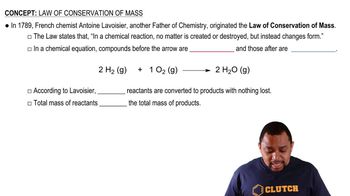Here are the essential concepts you must grasp in order to answer the question correctly.
Stoichiometry
Stoichiometry is the branch of chemistry that deals with the quantitative relationships between the reactants and products in a chemical reaction. It allows us to calculate the amounts of substances involved based on balanced chemical equations. In this problem, stoichiometry will help determine how much CuO and Cu2O were present in the original mixture by relating their masses to the mass of the produced Cu.
Recommended video:
Reduction Reactions
Reduction reactions involve the gain of electrons or a decrease in oxidation state by a substance. In this context, CuO and Cu2O are reduced to form elemental copper (Cu). Understanding the reduction process and the oxidation states of copper in these compounds is essential for determining how much of each compound was present in the original mixture.
Recommended video:
Oxidation and Reduction Reactions
Mass Conservation
The law of conservation of mass states that mass is neither created nor destroyed in a chemical reaction. This principle is crucial for solving the problem, as the total mass of the reactants (CuO and Cu2O) must equal the mass of the products (pure Cu and any remaining oxygen). By applying this law, we can set up equations to find the original amounts of CuO and Cu2O in the mixture.
Recommended video:
Law of Conservation of Mass



